
The flag of South Africa was designed in March 1994 and adopted on 27 April 1994, at the beginning of South Africa's 1994 general election, to replace the flag that had been used since 1928.

The flag of Vatican City was adopted on 7 June 1929, the year Pope Pius XI signed the Lateran Treaty with Italy, creating a new independent state governed by the Holy See. The Vatican City flag is modeled on the 1808 yellow and white flag of the earlier Papal States, to which a papal tiara and keys were later added. The Vatican also refers to it, interchangeably, as the flag of the Holy See.

The current flag of the Australian Capital Territory was officially adopted by the Australian Capital Territory Legislative Assembly in 1993.

The national emblem of Belarus features a ribbon in the colors of the national flag, a map of Belarus, wheat ears and a red star. It is sometimes referred to as the coat of arms of Belarus, although in heraldic terms this is inaccurate as the emblem does not respect the rules of conventional heraldry. The emblem is an allusion to one that was used by the Byelorussian SSR, designed by Ivan Dubasov in 1950, with the biggest change being a replacement of the Communist hammer and sickle with an outline map of Belarus. The Belarusian name is Dziaržaŭny herb Respubliki Biełaruś, and the name in Russian is Gosudarstvennyĭ gerb Respubliki Belarusʹ.

The coat of arms of Bosnia and Herzegovina was adopted in 1998, replacing the previous design that had been in use since 1992 when Bosnia and Herzegovina gained independence. It follows the design of the national flag. The three pointed shield is used to symbolize the three major ethnic groups of Bosnia, as well as allude to the shape of the country.

The national flag of Zimbabwe consists of seven even horizontal stripes of green, gold, red and black with a white triangle containing a red five-pointed star with a Zimbabwe Bird. The present design was adopted on 18 April 1980. The soapstone bird featured on the flag represents a statuette of a bird found at the ruins of Great Zimbabwe. The bird symbolises the history of Zimbabwe; the red star beneath it officially stands for the nation's aspirations but is commonly thought to symbolise socialism, and the revolutionary struggle for freedom and peace. The design is based on the flag of Zimbabwe's ruling party, the Zimbabwe African National Union – Patriotic Front.

The flag of Yukon, is a green, white, and blue tricolour with the coat of arms of Yukon at the centre above a wreath of fireweed, the territorial flower. An official flag for Yukon was created during the 1960s, a decade in which the national flag of Canada was chosen as well as several other provincial flags were created. The flag of Yukon was officially selected from a territory-wide design competition in 1967, with the winning design adopted on March 1, 1968.
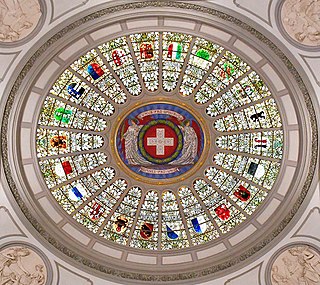
Each of the 26 modern cantons of Switzerland has an official flag and a coat of arms. The history of development of these designs spans the 13th to the 20th centuries.

The coat of arms of Toronto, Ontario, Canada, was designed by Robert Watt, the Chief Herald of Canada at the time, for the City of Toronto after its amalgamation in 1998. The arms were granted by the Canadian Heraldic Authority on 11 January 1999.

The current coat of arms of Zimbabwe was adopted on 21 September 1981, one year and five months after the national flag was adopted. Previously the coat of arms of Zimbabwe was identical to the former coat of arms of Rhodesia.

Ermelo is the educational, industrial and commercial town of the 7,750 km2 Gert Sibande District Municipality in Mpumalanga province, Republic of South Africa. It is both a mixed agriculture and mining region. It is located 210 km east of Johannesburg.

The coat of arms of Egypt is known as the Republican Eagle or Egyptian Golden Eagle, is a heraldic golden eagle, facing the viewer's left (dexter). The eagle's breast is charged with an escutcheon bearing the red-white-black bands of the flag of Egypt rotated vertically, whilst the eagle's talons hold a scroll bearing the official name of the state written in Kufic script. The earliest version of the Eagle of Saladin was that used as the flag of Saladin, the first Sultan of Egypt, whilst the modern version of the eagle was adopted during the Egyptian Revolution of 1952. Subsequently, the modern design of the Eagle of Saladin was adopted as the coat of arms of numerous other states in the Arab World, namely the United Arab Republic, North Yemen, Iraq, South Yemen, the Libyan Arab Republic, and Palestine. The current eagle was modified in 1984 to its present form.

The coat of arms of Malta is the national coat of arms of the country of Malta.
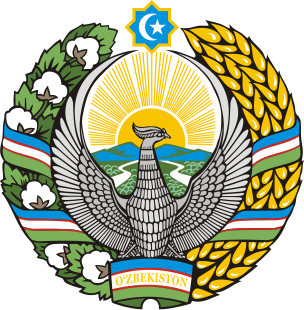
The state emblem of Uzbekistan was formally adopted on July 2, 1992 by the newly establish Republic of Uzbekistan. It bears many similarities to the emblem of the previous Uzbek SSR, which Republic of Uzbekistan succeeded. Like other post-Soviet republics whose symbols do not predate the October Revolution, the current emblem retains some components of the Soviet one. Prior to 1992, Uzbekistan had an emblem similar to all other Soviet Republics, with standard communist emblems and insignia.

The coat of arms of the British Virgin Islands consists of a green escutcheon (shield) charged with a woman in a white dress and gold-coloured sandals, holding a lit golden oil lamp and surrounded by eleven other golden lamps. Adopted shortly after the islands became a Crown colony, it has been the coat of arms of the British Virgin Islands since 1960. The escutcheon dates from the early 19th century and is featured on the flag of the territory. The woman and the lamps represent Saint Ursula and her companions, the namesake of the islands.
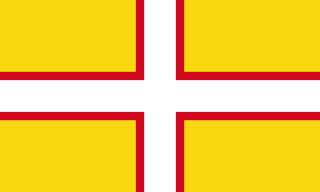
The flag of Dorset is the flag of the English county of Dorset. It was chosen as the flag of Dorset on 16 September 2008 following a vote open to all Dorset residents, and organised by Dorset County Council. The unitary authorities of Bournemouth and Poole declined an invitation to participate. The flag has subsequently been registered at the Flag Institute and added to their UK Flags Register.
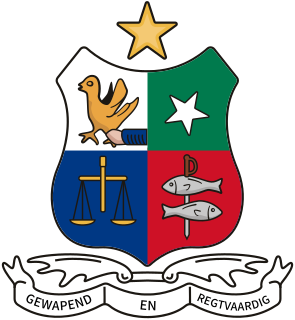
The coat of arms of Stellaland was the official heraldic symbol of the short-lived Stellaland state in South Africa from 1883 to 1885. It was later revived as the municipal arms of Stellaland's capital, Vryburg.

The Johannesburg municipal council assumed a coat of arms in 1907, and had it granted by the College of Arms on 20 August 1907. The design, by W. Sandford Cotterill, consisted only of a shield : Vert, a fess between three battery stamps Or. The motto was Fortiter et recte.
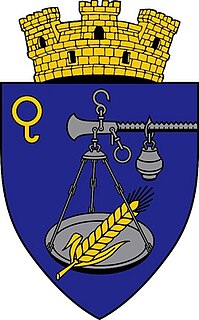
The coat of arms of Cimișlia is the official coat of arms of the city of Cimișlia, in the Cimișlia District, Moldova. It consists of a silver balance coming out of the coat of arms on the left and that holds an ear of grain representing the wealth of the city's cereals. On the canton (corner) of the coat of arms is the danga of a Tatar tribe, a unique symbol of Cimișlia. The field is blue, representing the sky and other values and elements. Above the coat of arms is a mural crown with three towers. It was proposed to use the coat of arms on the flag of Cimișlia, which was approved for a few months before the flag was changed again to its current form.

 Flag ratio: 2:3
Flag ratio: 2:3
 Former flag used between 1970 and 1997
Former flag used between 1970 and 1997

















